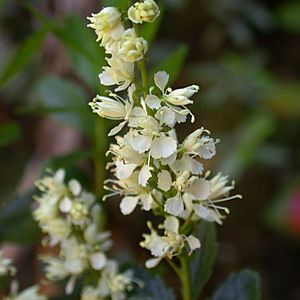Tetracarpaea facts for kids
Quick facts for kids Tetracarpaea |
|
|---|---|
 |
|
| Scientific classification | |
| Genus: |
Tetracarpaea
|
| Species: |
tasmannica
|
Tetracarpaea is a special kind of plant, and it's the only one in its own plant family called Tetracarpaeaceae. Some plant scientists used to group it with other families like Haloragaceae, but now we know it's unique.
This plant has only one species, which is called Tetracarpaea tasmannica. It's an evergreen (meaning it keeps its leaves all year) and grows as a bushy shrub. You can find it in the cooler, higher areas of Tasmania. Its height can vary, usually from about 15 centimeters to 1 meter tall. The leaves are shiny and small, with clear lines (veins) on them. At the ends of its branches, you'll see lots of tiny, white flowers. People don't usually grow this plant in gardens, but it can be grown from cuttings.
For a long time, scientists weren't sure where Tetracarpaea fit in the plant world because it has a mix of features from different groups. But thanks to modern science, especially by looking at its DNA, we now know that Tetracarpaea is part of a group called the Haloragaceae alliance. This group includes a few other families like Aphanopetalaceae and Penthoraceae. All these families belong to a larger group of plants called the order Saxifragales.
What Does It Look Like?
Tetracarpaea tasmannica is a smooth, evergreen, upright, and bushy shrub. It usually grows between 15 and 60 centimeters tall, but sometimes it can reach up to 1 meter in height and 70 centimeters wide.
Its leaves are shaped like an oval or a spoon, about 2.5 centimeters long and 8 millimeters wide. They sit on a small stem (called a petiole) about 2 millimeters long. The veins on the leaves are easy to see and go almost to the edge. The edges of the leaves are either jagged or rounded. Both sides of the leaves have a thick, protective layer called a cuticle.
The inflorescences (clusters of flowers) are dense and stand upright at the ends of the branches, growing up to 5 centimeters long. The flowers appear in autumn. They have both male and female parts, are round and symmetrical, and are about 5 to 10 millimeters wide. The 4 green leaf-like parts (called sepals) stay on the plant even after the fruit ripens. The 4 petals are white and shaped like spatulas.
The flowers have either 4 or 8 stamens (the male parts). If there are 4, they are directly across from the sepals. The pollen-producing parts (called anthers) are attached at their base.
The ovary (the part that holds the seeds) is at the top of the flower and has 4 large sections called carpels. These carpels are usually separate, but sometimes 2 or 3 of them are joined at the bottom, or rarely, even halfway up. They stand upright and have a seam along one side. Along this seam, there are 1 to 3 rows of many tiny ovules (which become seeds). Each ovule has one or two protective layers.
The ovary doesn't get much bigger after the flower opens. The fruit is made of 4 small pods (called follicles) that are joined at the base. Inside, there are many seeds, each about half a millimeter long.
Its Plant Family Tree
William Jackson Hooker gave the name Tetracarpaea to this plant in 1840. The name refers to its four clear and separate carpels. At that time, he thought it belonged to the Cunoniaceae family.
From then until the late 1900s, most scientists placed Tetracarpaea in either Cunoniaceae, Escalloniaceae, or Saxifragaceae. People believed these three families were related, but today, we know they belong to different plant groups (orders).
Now, we know that Cunoniaceae is in the Oxalidales order. Escalloniaceae is even further away from Tetracarpaea, belonging to a group called the campanulids. In the latest plant classification system (APG III), Escalloniaceae is the only family in its own order, Escalloniales. By studying the DNA of plants, scientists have placed Tetracarpaea in the order Saxifragales. It's in the "core Saxifragales" group, but it's not closely related to the Saxifragaceae family, which is now defined much more narrowly.
A Look Back: How Its Story Unfolded
After William Jackson Hooker named Tetracarpaea and placed it in Cunoniaceae, George Bentham agreed. Later, in 1865, George Bentham and Joseph Dalton Hooker moved Tetracarpaea to the Escalloniaceae family.
Adolf Engler put Tetracarpaea in Saxifragaceae, but his definition of Saxifragaceae was very broad and included what is now Escalloniaceae. Engler first placed Tetracarpaea in a subgroup of Escallonioideae, then later gave it its own subgroup.
In 1943, Takenoshin Nakai was the first to suggest that Tetracarpaea should have its own family, calling it "Tetracarpaeaceae." However, John Hutchinson didn't follow this idea and kept it in Escalloniaceae.
Arthur Cronquist placed Tetracarpaea in Grossulariaceae, a family now known to contain only the genus Ribes. Armen Leonovich Takhtajan sometimes put Tetracarpaea in Escalloniaceae and sometimes in Tetracarpaeaceae. Most recently, in 2009, he placed it in Tetracarpaeaceae.
In 1988, Matthew H. Hils and others studied the inside (anatomy) of Tetracarpaea's wood and leaves. They concluded that Tetracarpaea was much more similar to Saxifragaceae than to Cunoniaceae or Escalloniaceae.
The first molecular phylogenetic studies (which look at DNA to understand relationships) of the order Saxifragales weren't very clear. But in 2008, by comparing the DNA sequences from the entire chloroplast genome, scientists like Shuguang Jian were able to figure out exactly where Tetracarpaea fits within Saxifragales. These results were very strong and helped confirm its place.

